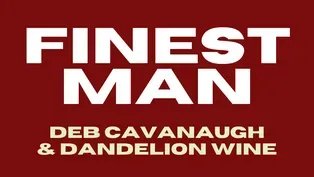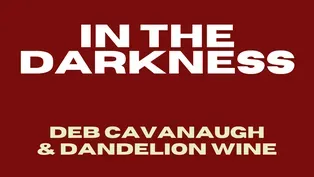
The Punch That Inspired an Artist
Clip: Season 8 Episode 23 | 6m 48sVideo has Closed Captions
Artist Abraham Ferraro takes a punch from a mechanical boxing arm for his vision.
Abraham Ferraro is a unique artist that takes his art seriously. He believes in the power of the experience and the lengths that artists must go to bring their vision to life. In this segment, he takes a punch from a spring-loaded mechanical boxing arm as part of his artistic vision.
Problems with Closed Captions? Closed Captioning Feedback
Problems with Closed Captions? Closed Captioning Feedback
AHA! A House for Arts is a local public television program presented by WMHT
Support provided by the New York State Council on the Arts (NYSCA), M&T Bank, the Leo Cox Beach Philanthropic Foundation, and is also provided by contributors to the WMHT Venture...

The Punch That Inspired an Artist
Clip: Season 8 Episode 23 | 6m 48sVideo has Closed Captions
Abraham Ferraro is a unique artist that takes his art seriously. He believes in the power of the experience and the lengths that artists must go to bring their vision to life. In this segment, he takes a punch from a spring-loaded mechanical boxing arm as part of his artistic vision.
Problems with Closed Captions? Closed Captioning Feedback
How to Watch AHA! A House for Arts
AHA! A House for Arts is available to stream on pbs.org and the free PBS App, available on iPhone, Apple TV, Android TV, Android smartphones, Amazon Fire TV, Amazon Fire Tablet, Roku, Samsung Smart TV, and Vizio.
Providing Support for PBS.org
Learn Moreabout PBS online sponsorship- I'm in Albany, New York, about to look at the installations and performances of Abraham Ferraro.
Let's go.
- My artwork has always been about art itself and what it's like to be an artist.
I do large scale installations where I have a bunch of light switches and literally miles of extension cords and they light up art and not art signs.
I've done performance work where there're literally tons of steel and wood and there are these really laborious projects that boil down to the creation of a piece of artwork, like a drawing or painting.
I also make work that's more on the craftier side.
I do these orbs that are incredibly detailed.
I mean, I even consider house renovations to be artwork.
This is the flavor space saver Black beans.
I like to do anything that unites hands-on skill with creative thought.
When I was making artwork in graduate school I was making these pieces that involved a lot of interaction with the viewer and at a certain point it became obvious to me that the pieces were successful when I was around demonstrating them.
So it became very obvious that I needed to be around and do a performance.
And so the very first one that I was working on was the knockout artist And it was a spring loaded mechanical boxing arm.
And originally I thought, wouldn't it be great if it came to my art show?
And there was this spring loaded mechanical boxing arm that would threaten to punch you in the face as you walk by.
Well, obviously cause legal reasons.
That was a terrible idea.
So then it became a natural that I was gonna be the one who was gonna get punched in the face by this spring loaded mechanical arm.
And during the act of that there would be these paintbrushes that would dangle below the boxing glove and they would strike a canvas just as I was being punched in the face.
And then over a 12 round match I would create this abstract action painter.
The boxing glove is actually left-handed.
And then, so it's my alter ego.
The knockout artist is essentially me.
A lot of my work is autobiographical.
When you're making artwork, you're always like in the process of of beating yourself up you are trying to create artwork.
You're debating on whether or not it's good art or bad art or if it's art at all, are people gonna like it?
So you're always in in competition with yourself.
The stationary climber was a 15 foot tall climbing tread wall.
I would have these cables and employees hooked up to my arms.
And so that would go back to a drawing table and it would pull a marker in the X or Y coordinate.
And as I climbed the tread wall, the tread wall was connected to its drawing table and it would spin the drawing table in circles.
It would also push the climbing jig from the center of the circle to the outside of the circle.
So you have these four different movements that would make this scribble line draw.
The performance pieces, a lot of them were actually really difficult to make and I was really kind of jealous about painters and photographers that could just send their artwork to gallery and they would get installed for them.
I mean, you know, with the performance work, it was always me setting up these pieces and it was really hard to sustain.
People look at the knock art artists and they're thinking oh, that's really abusive.
And why would you do that to yourself?
Well, I mean, that was the easy part.
- So I was struggling and I was doing these really strenuous laborious performances and the end, you really only have this tiny little drawing to show for The Melbourne artwork directions was really an answer to the problem that I had created with my performance pieces.
I really wanted a piece of artwork that was lightweight and easy to transport.
Originally started in 2008 when I got into a show in Scotland.
It was called In Transit.
And it was all about how artwork gets from A to B.
And so I thought, oh, I'll just make a funny looking box with holes in it and mail it to Scotland and they'll take it right off the the delivery truck and put it on a pedestal and that's your piece.
And I thought everyone was gonna do that, right?
So I went to go check out the show online and to my surprise, no one else had done anything like that.
And that's when I had that that eureka moment, I'm like, huh, I'm onto something here.
It wasn't long before I figured out how to make a bunch of pieces interconnect and turn into this monstrosity that has become now.
I, I definitely am compelled to make artwork.
I really need to build things.
It is definitely the thing that has defined my life without the ability to create something my life would definitely be not as full.
The Lightfoot series are really about the myth of creation.
Like who really declares what is art.
I can say that it's art, but if it's not validated by the art institutions or by the art audience, then doesn't it really matter?
Video has Closed Captions
Preview: S8 Ep23 | 30s | Explore the lengths artists go to bring their vision to life. (30s)
Deb Cavanaugh & Dandelion Wine "Finest Man"
Video has Closed Captions
Clip: S8 Ep23 | 3m 12s | Deb Cavanaugh and Dandelion Wine share their unique "psychedelic folk" sound. (3m 12s)
Deb Cavanaugh & Dandelion Wine "In The Darkness"
Video has Closed Captions
Clip: S8 Ep23 | 3m 54s | Deb Cavanaugh and Dandelion Wine share their unique "psychedelic folk" sound. (3m 54s)
Telling the Stories of Black Achievement in "Outta The Muck"
Video has Closed Captions
Clip: S8 Ep23 | 10m 51s | Ira McKinley and Bhawin Suchak discuss their documentary Outta The Muck. (10m 51s)
Providing Support for PBS.org
Learn Moreabout PBS online sponsorshipSupport for PBS provided by:
AHA! A House for Arts is a local public television program presented by WMHT
Support provided by the New York State Council on the Arts (NYSCA), M&T Bank, the Leo Cox Beach Philanthropic Foundation, and is also provided by contributors to the WMHT Venture...















